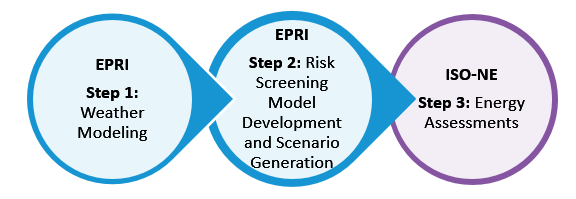Latest assessment from study on weather and energy security finds higher possibility for shortfall in winter 2032

The second set of results from an innovative study examining how the region’s power system would fare under stressful weather and operational conditions shows the possibility of an energy shortfall increasing between winter 2027 (the first period studied) and winter 2032 (the second period studied) under some scenarios.
While the probability remains low, the increase over the five-year span reflects the impact of expected generation retirement over the next several years, coupled with a forecasted increase in demand due to electrification of heating and transportation.
The finding comes from the latest assessment performed as part of Operational Impact of Extreme Weather Events, a probabilistic energy-security study undertaken jointly by the ISO and the Electric Power Research Institute (EPRI). The study, which seeks to inform the region about future energy adequacy risks and provide context for assessing solutions, is one of several key projects undertaken by the ISO to help New England prepare for tomorrow’s greener grid.
Stephen George, director, Operational Performance, Training, and Integration, and Jinye Zhao, technical manager, Advanced Technology Solutions, shared the new results at the Aug. 15 NEPOOL Reliability Committee meeting; preliminary results for winter 2027 were presented in May.
Process and findings
Recognizing the increasingly important role weather plays in power system operations, the study examines how factors like temperature, cloud cover, and wind speed will impact the region’s energy supplies in the future, when the regional grid is more heavily powered by renewable resources sensitive to these weather conditions. The study also takes into account the evolving grid demand patterns that will continue to change as more behind-the-meter photovoltaic (BTM PV) resources come online and electrification of the heating and transportation sectors increases.
The study is being undertaken in three major steps, with EPRI providing weather modeling and risk screening model development, and ISO New England completing the actual energy assessments, using the 21-day energy assessment tool. The 21-day tool is a one-of-a-kind energy supply outlook that offers a three-week analysis of anticipated power system conditions, taking into consideration variables such as fuel supplies, weather, and electricity demand.

The study looked at both “expected” and “worst case” scenarios for winter 2032. To quantify what a “worst case” situation might look like, one 21-day event showed the highest potential energy shortfall could equal roughly 2.6% of the region’s electricity demand across the 21 days.
Results are key outputs of the study, but represent just one snapshot in time. In the long term, a critical win from the study has been the creation of a framework that allows the ISO to repeatedly assess future scenarios.
“The tool helps ensure that our understanding of how the power system will operate evolves alongside the resource mix, technology, and myriad other factors impacting it,” said Vamsi Chadalavada, Executive Vice President and Chief Operating Officer. “This is a very dynamic risk profile, which means there is significant opportunity for change over the next several years. Repeating the studies ensures we understand the potential for risk as it evolves, so we can work to mitigate those risks before they materialize.”
- Categories
- Inside ISO New England
- Tags
- system operations, weather, winter

